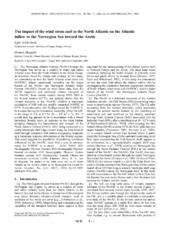The impact of the wind stress curl in the North Atlantic on the Atlantic inflow to the Norwegian Sea toward the Arctic
Peer reviewed, Journal article
Permanent lenke
https://hdl.handle.net/1956/428Utgivelsesdato
2003-09-04Metadata
Vis full innførselSamlinger
- Geophysical Institute [1228]
Originalversjon
https://doi.org/10.1029/2003gl017932Sammendrag
The Norwegian Atlantic Current (NwAC) through the Norwegian Sea serves as a conduit of warm and saline Atlantic water from the North Atlantic to the Arctic Ocean, an important factor for climate and ecology. In this study, we concentrate on how the North Atlantic wind stress curl (NAWSC) affects interannual variability on the major branch of the NwAC—the Norwegian Atlantic Slope Current (NwASC). Based on wind stress data from the NCEP reanalysis and estimated volume transport of the NwASC from current records during 1995–2003 in the Svinøy section (62°N), our analysis shows that the volume transport in the NwASC exhibits a maximum correlation of 0.88 with the zonally integrated NAWSC at 55°N 15 months earlier. Our findings reveal the NAWSC to be a major forcing for interannual variability of the NwASC in the range of 3.0- to 5.3 Sv (Sv = 106 m³ s-¹). The 15 month time lag appears to be in accordance with a forced baroclinic Rossby wave in response to the local Ekman pumping changing the baroclinicity and strength of the North Atlantic Current (NAC). After being converted to a nearly barotropic shelf edge current along the Irish-Scottish shelf through interaction with bottom topography, it appears as a barotropic response downstream in the Svinøy section. This result suggests the possibility of predicting conditions influenced by the NwASC more than a year in advance, using the NAWSC as a proxy.
